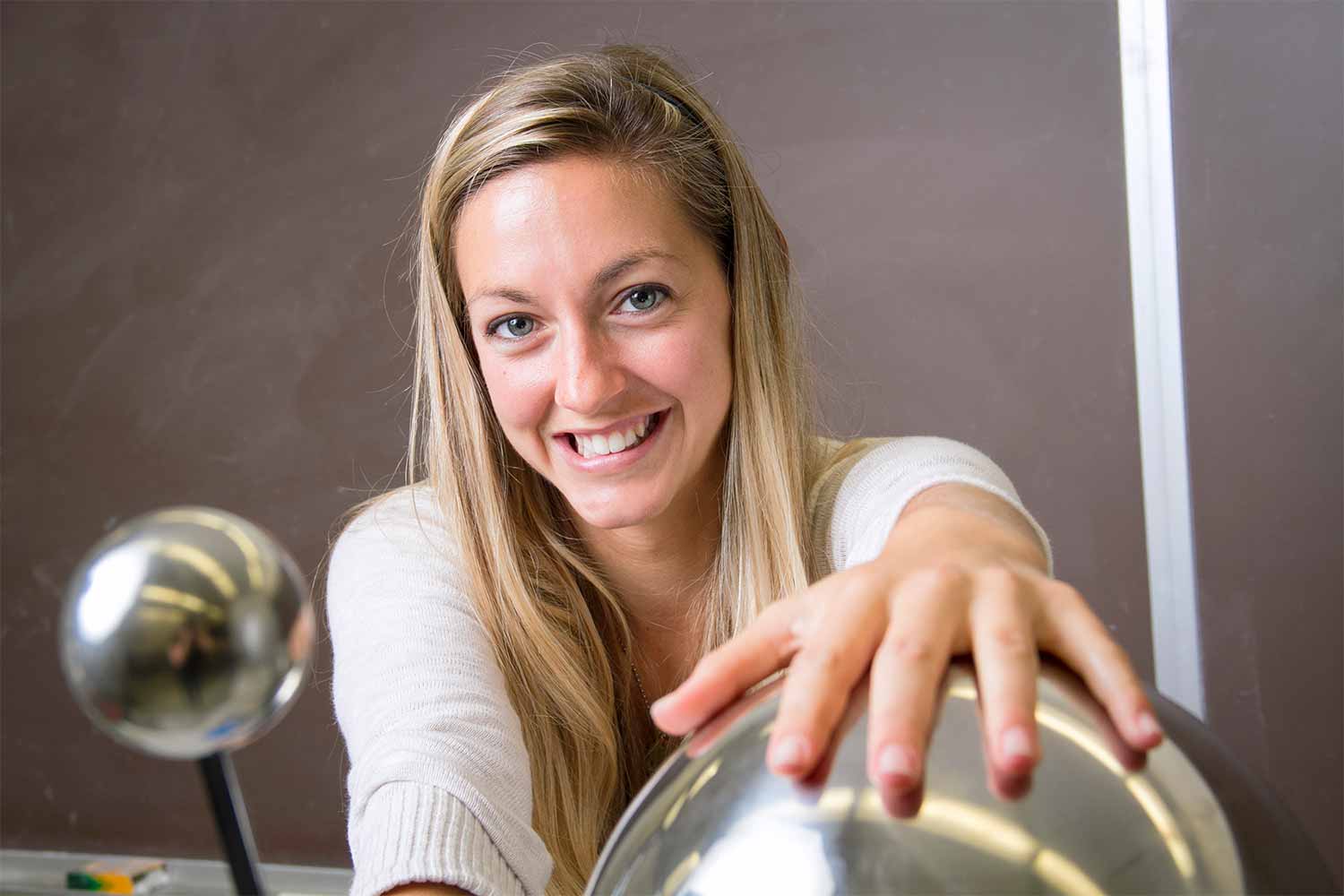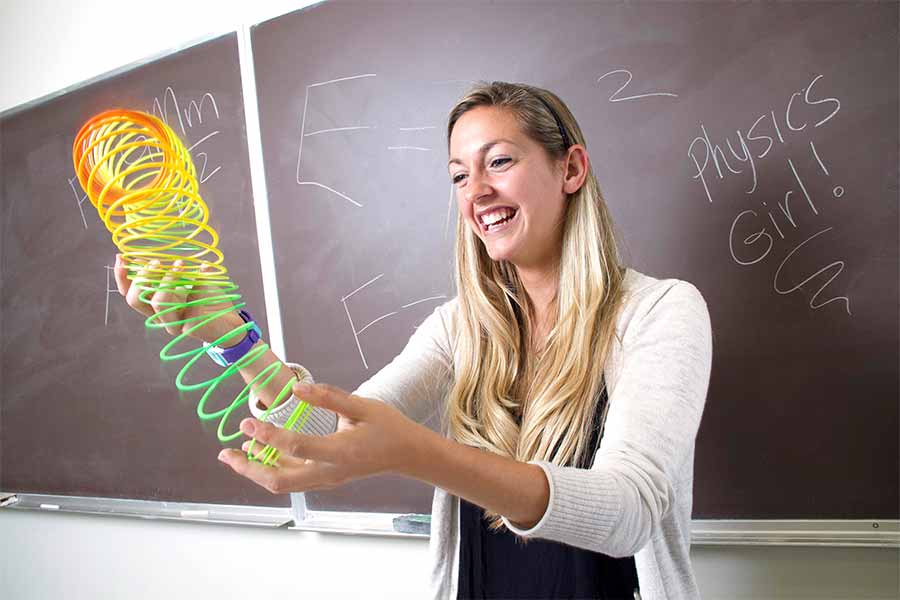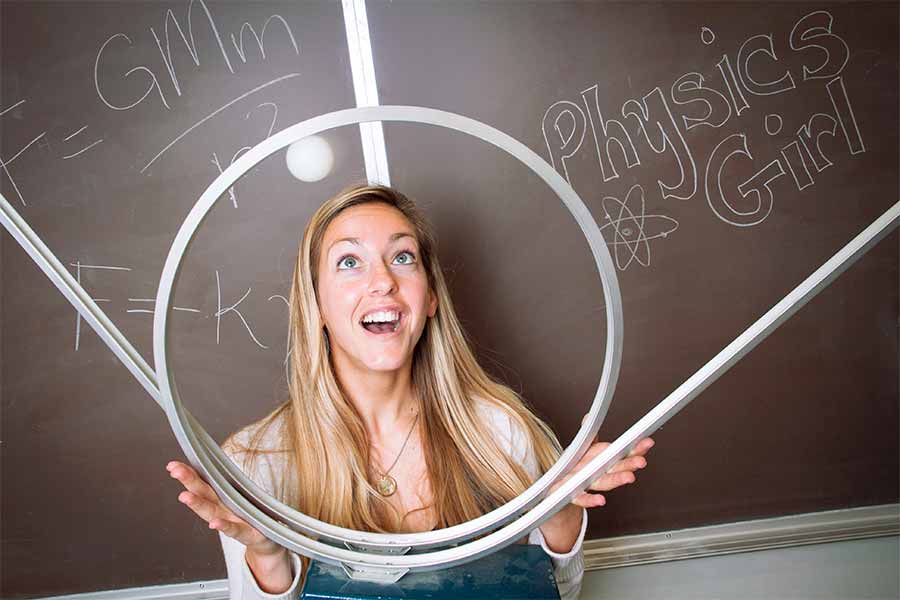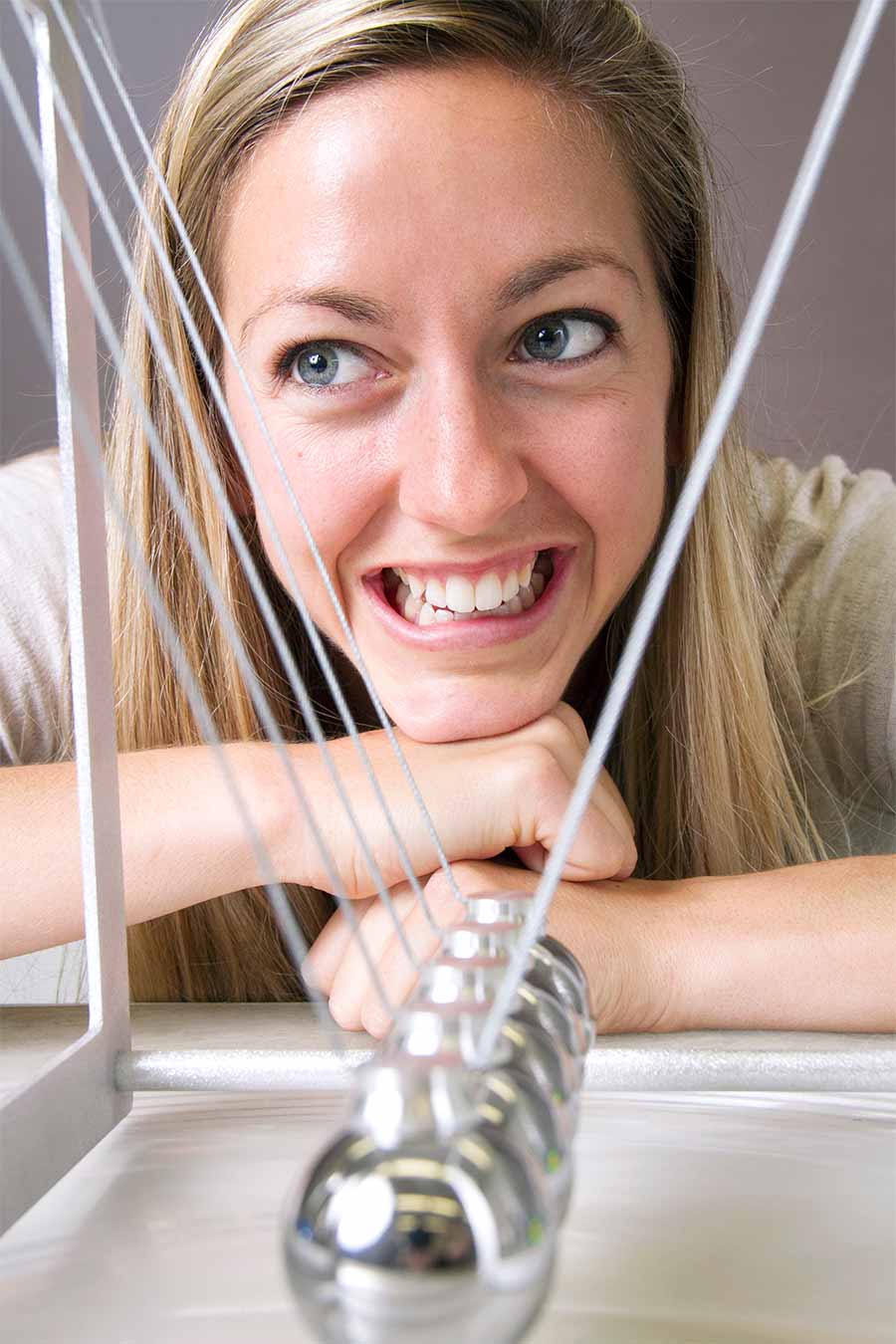By:
- Kim McDonald
Published Date
By:
- Kim McDonald
Share This:
UC San Diego’s ‘Physics Girl’ Wins National Competition

Dianna Cowern. Photos by Erika Johnson/University Communications
YouTube videos by outreach coordinator with passion for getting girls into science aim to make physics entertaining and informative
Videos featuring Rihanna, One Direction and Bruno Mars are, not surprisingly, among YouTube’s most viewed channels. Videos on physics? While some videos on physics have gained a cult-like following and hundreds of thousands of views, the subject that makes most people’s eyes glaze over still can’t compete with entertainers like Katy Perry in the YouTube world.

That could change, however, thanks to an energetic young physicist who works as an outreach coordinator at UC San Diego’s Center for Astrophysics and Space Sciences and who uses her upbeat and sometimes wacky personality to communicate physics to the public on YouTube with videos that are not only informative, but also fun and cool.
Earlier this week, Dianna Cowern was awarded the top video prize in a national science communications competition by the Alan Alda Center for Communicating Science at SUNY Stonybrook for her entertaining YouTube production explaining the physics of color. The award, given annually for the past three years as part of a contest called the “Flame Challenge,” was presented to her at the World Science Festival in New York City by the actor himself.

“Alan Alda started this competition a couple of years ago because he wondered what a flame was when he was a kid, and he got the standard answer from his teachers that didn’t go into any real depth or explain it,” explained Cowern, adding that the “Flame Challenge” is different from other science communications contests because it’s specifically designed to reach an audience of 5th graders. “Every year, he’s posed a new question that kids have submitted to him for the contest. Last year, the question was ‘What is Time?’ And this year, it was ‘What is Color?’”
Cowern’s prize-winning video, which was voted for by 27,000 students from around the world, is the most recent post to her YouTube channel called “Physics Girl,” which she started on her own two years ago because of her passion to get more girls interested in science. As part of her day job, Cowern works with Adam Burgasser, an associate professor of physics, on developing “Beach Physics,” an innovative new program designed to get middle school and high school students interested in physics by teaching them about physics that happens at the beach (it’s a perfect fit for her, since she grew up near the beach on the island of Kauai). Cowern also sets up exhibits and demonstrations at science fairs and festivals, volunteers for UC San Diego’s Young Physicists Program and works at the Reuben H. Fleet Science Center Center in Balboa Park doing science education outreach.
Cowern’s Physics Girl videos run the gamut from demonstrating the physics of standing waves with a rope and vibrating plates sprinkled with sand, to explaining the Hubble Space Telescope’s Deep Field Survey, to finding out on a stovetop whether dissolved solids in boiled water escape with steam (if you’re wondering, they sometimes do). Her high-energy productions, sometimes illustrated with her own drawings and set to background music and sound effects, are inspired by Bill Nye the Science Guy, astrophysicist Neil deGrasse Tyson and two of her high school science teachers on Kauai (at a school so small it had only 80 students). “I had two teachers for physics who were so fantastic,” she recalls, pausing to add extra emphasis in her engaging and exuberant style of speech, one of the reasons that makes her videos so fun to watch. “They were entertaining, but very educational and they answered every question.”

Cowern’s youth (she just celebrated her 25th birthday on what she calls “Star Wars Day” or “May the 4th be with you”), sometimes quirky humor and enthusiasm provide her with an obvious edge over most professors in connecting with younger audiences. But she’s no lightweight when it comes to science. She graduated from MIT with a degree in physics, participated in a research project there on dark matter (the invisible stuff that makes up most of the mass in the universe), did research on low-metallicity stars at the Harvard-Smithsonian Center for Astrophysics after graduation, then spent time as a software engineer at General Electric in Foxboro, Mass, before making the move to San Diego to work with Burgasser, one of her former professors at MIT.
Cowern started making the videos in her off hours while she was working at GE because she was interested in getting more girls into science and interested in science communication. “I didn’t have much time to work on the videos when I was at GE, and I didn’t think the first ones were very good,” she confesses. “But I’m definitely learning a lot, reading about new techniques and learning how to make the videos more visually appealing, as well as grabbing the audience’s attention with some type of video at the beginning instead of talking about physics for three minutes and then showing something cool.”
Burgasser, who received his undergraduate degree in physics at UC San Diego in 1996 and was lured back to here from MIT in 2009, saw her first videos two years ago and was impressed. That’s when he offered her the job here.
“It’s clear she has an innate talent in communicating science,” says Burgasser. “Many physics videos online are either rigorous or entertaining, or more likely neither. Her videos are both. They’re also deeply researched. She has a dogged persistence for uncovering real facts and not just taking hand-waving arguments or ascribing something to physics principles or effects.”
“I got to see Dianna's intelligence and persistence very early on, since I taught her very first physics class at MIT,” he adds. “This is one of the hardest classes that MIT freshmen take, and she initially struggled up to the first quiz. But she came to my office hours and put in the study time, and by the end of the semester she was helping other students learn the concepts and work with the equations. That is true grit. That and the fact that she never doubts that she can do, or at least try, something new, were both strong personality traits that led me to her.”
Burgasser saw a notice about the Flame Challenge competition earlier this year and suggested Cowern enter. She was hesitant at first because the notice was specifically looking for “scientists” to submit videos and “she didn’t think she was a scientist,” recalls Burgasser. “So I challenged her on that. Was she investigating physical phenomena? Yes! In a quantitative and qualitative way? Yes! And identifying research-validating methods of conveying scientific information? Yes! And, of course, she did have a physics degree from MIT and worked on dark matter searches. Once I convinced her that what she was doing was actually science, she went all in, but it definitely opened this little door of inquiry into who gets to ‘be’ a scientist.”
There were a few other obstacles. “I was in Ireland at the time and I had five days to do the video when I got back, so I spent the entire week working on it,” remembers Cowern. “But it paid off.”
In a Big Way. Not many researchers her age have been invited to lunch with Alan Alda or been feted by famous scientists at the World Science Festival. So how does she feel now about not continuing as a research scientist?
“Every once in a while I’ll kick myself for leaving physics and going into physics education,” she says. “And I always wonder whether I’ll go back because I really do love physics. But what I’m doing now is almost better because I get to learn about a lot of different topics instead of having to do research for 10 years on the same project.”
The project that she and Burgasser are focusing on right now, Beach Physics, stems from their love of the beach and their belief that it would be a cool way to get kids interested in physics without realizing they’re actually learning physics.
Burgasser grew up in Buffalo, NY, and during his first week as an undergraduate at UC San Diego, bought a surfboard and proceeded to teach himself to surf at nearby Black’s Beach. “Eventually, I also learned I needed a wetsuit,” remembers Burgasser, who still keeps a board in his third-floor office of the appropriately named SERF building (it actually stands for Science and Engineering Research Facility).
“If you ask the average middle school student or the average person on the street, they would probably only say they liked the beach and would either have no idea about physics or have fear about it,” Burgasser says about his Beach Physics project. “So how do we tackle fear? We tie it to something we enjoy. The beach is also a physics-rich environment with fluids, granular phenomena, waves, buoyancy, friction, radiation, heat, ballistic motion, states of matter, the night sky and the elements. These are literally laid out in front of you when you walk on the beach, so why not tap into that rich resource? So what I hope to achieve is that when a student or a parent or anyone walks on the beach they start to think about these physics ideas, and more importantly play with the idea a little.”
Burgasser, Cowern and their colleagues in the project had hoped to launch their online resource with videos and lessons that teachers can use, soon, but have been delayed because of lack of funding. Anyone interested in contributing to the project can contact Burgasser at aburgasser@ucsd.edu.
Share This:
Stay in the Know
Keep up with all the latest from UC San Diego. Subscribe to the newsletter today.



